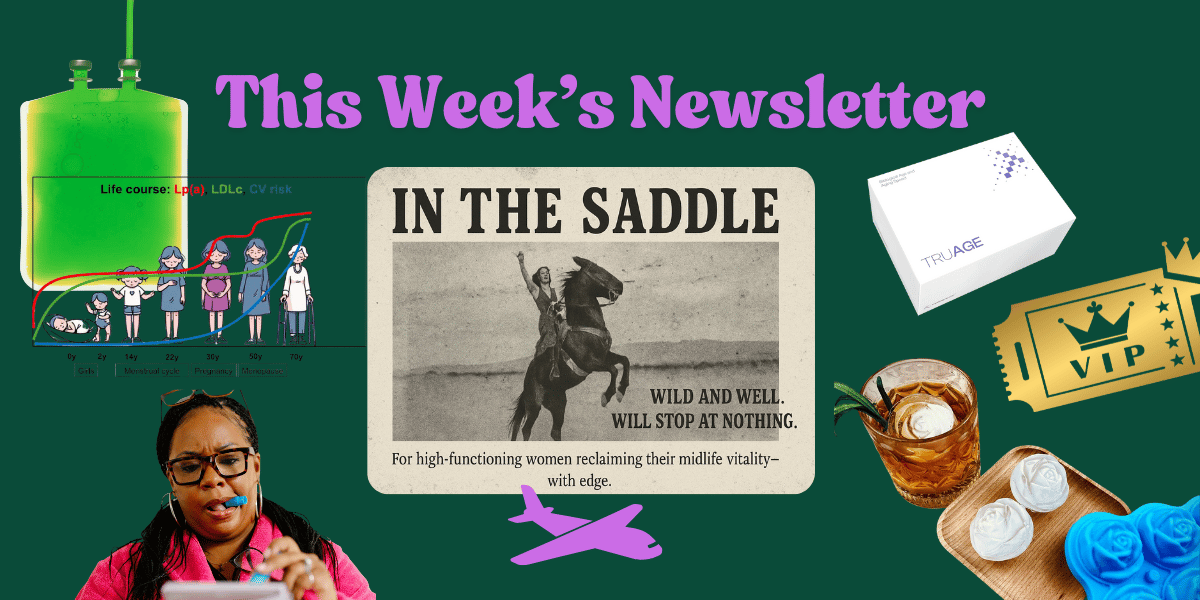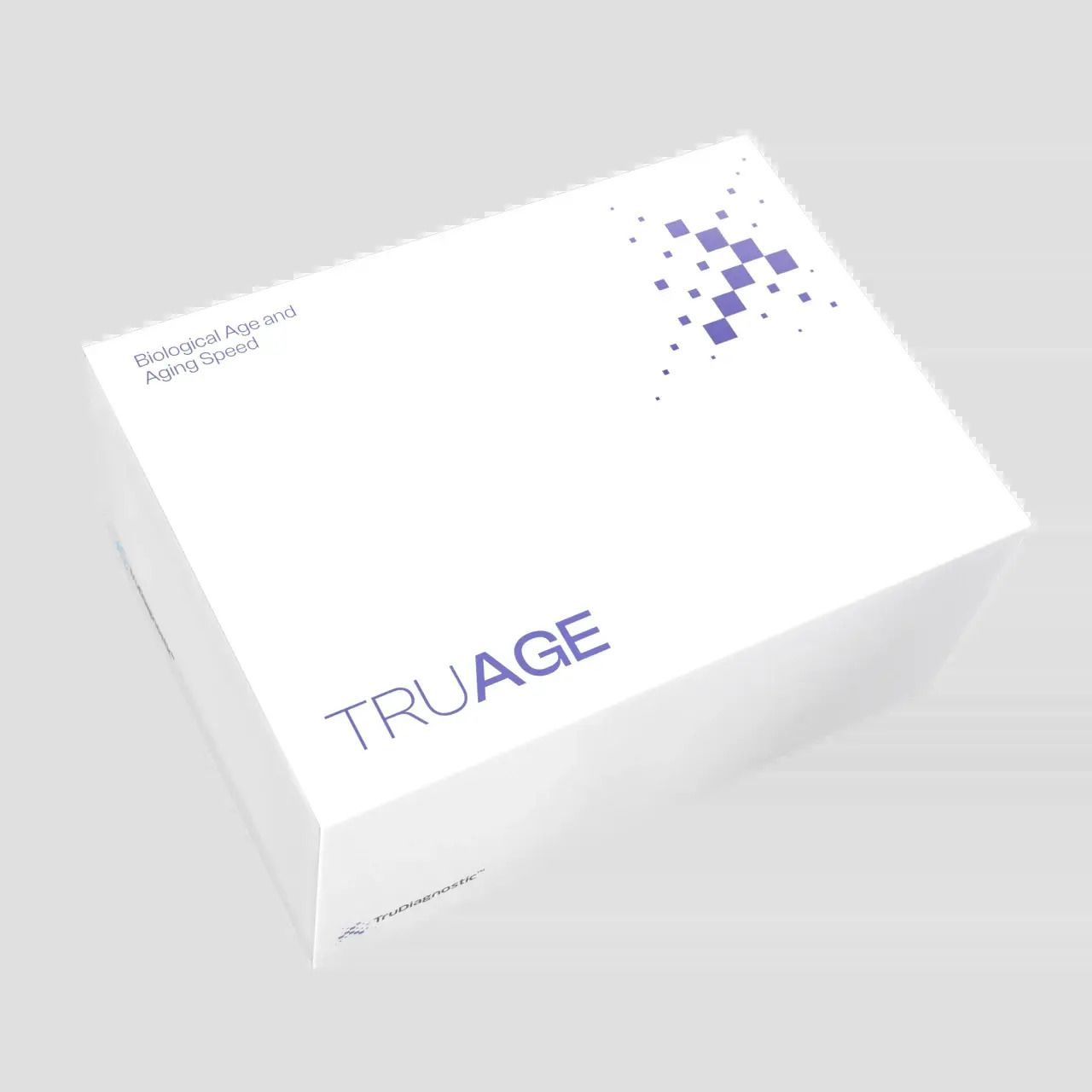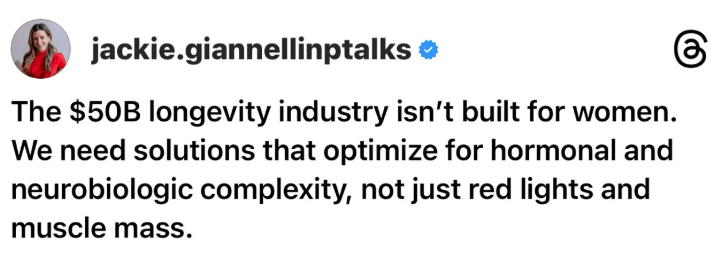
Jackie's Take: What's on My Mind in Women's Wellness ✍ 🤔 📰
🧬 Beyond the Longevity Bros: A Modern Framework for Women’s Preventive Testing
There’s a reason the phrase “longevity medicine” tends to conjure images of biohacking bros in cold plunges. The movement has been dominated by men, metrics, and an obsession with optimization—testosterone titration, peptide stacks, NAD+ infusions, and V02 performance testing.
But for women—especially those in midlife—the conversation needs a completely different center of gravity.
We’re not trying to reverse aging with a CGM and a six-pack. We’re just over here trying to protect brain function, preserve muscle, manage inflammation, stay sharp at work, and feel like ourselves through one of the biggest neurohormonal shifts of our lives.
The problem? The healthcare system still waits for us to break before it pays attention.
Preventive testing in traditional medicine often follows this logic: if there’s no FDA-approved drug or procedure for it, there’s no point in testing for it. But I believe that thinking misses the mark. Because knowing your risks—before problems start—can help you make proactive decisions that may change the trajectory of your healthspan.
This is where longevity medicine shines. Not as a luxury flex, but when curated for female physiology, it can function as a form of power.
But by the same token, longevity medicine right now feels like the wild, WILD west. Most still aren’t in agreeance about what the term actually stands for. And I’ll be honest with you—it’s hard even for the most seasoned clinicians to make sense of what is just over-engineered lip service and what really is worth your time.

So here is a start: I pulled together the longevity testing short list I wish more women had access to—the kind that I think can help you make moves before things fall apart. A few of these nudge the line between conventional and next-gen care, but if you’re here, I trust you’re ready for that. Wherever I could, I’ve included price points and access tips, so you’ll know exactly what you’re in for.
✅ Tests That Might Actually Change Your Life
1. Polygenic Risk Scores (PRS)
These tests go way beyond 23andMe. They analyze thousands of genetic variants to estimate your personal risk of diseases like coronary artery disease, breast cancer, and diabetes.
➡️ Why it matters: Harvard research shows PRS can predict risk on par with rare gene mutations—and guide earlier, smarter interventions.
💸 Cost: ~$250–$400, (Myriad, Allelica)
🔎 Use it if: You have a family history of chronic illness or cancer, or want insight that goes beyond basic gene identification. Future versions of PRS will help estimate not just if you’re at risk, but when—potentially sparing you years of unnecessary screening, anxiety, or even surgery. This is what truly personalized prevention look like, and I’m here for it.
2. Lipoprotein(a) Testing (Lp(a))
Lp(a) is a sticky, scratchy cholesterol particle that increases heart attack and stroke risk—especially in women. It’s genetic and doesn't respond to diet, so it often gets ignored.
➡️ Why it matters: Estrogen drop during perimenopause increases LDL and inflammation. Lp(a) adds gasoline to that fire.
💸 Cost: ~$75–$100, ask your practitioner to add it your regular blood panel!
🔎 Use it if: You have a family history of early cardiovascular disease or stroke. You technically only need to test this once per lifetime, however there is some evidence to suggest that hormone therapy may lower it modestly.
🔧Once you have tested: Use this tool to see how much your Lp(a) level increases your risk of having a heart attack or stroke, and get specific guidance about what you can do to lower your risk if your Lp(a) level is elevated.

American Journal of Preventive Cardiology, Volume 20, December 2024, 100885
3. DEXA Scan (Bone Density)
Standard care says wait until 65. That’s nonsense. Women can lose 10–20% of their bone density in the five years around menopause.
➡️ Why it matters: Once you fracture, it’s too late. DEXA gives you the chance to intervene early with strength training, nutrition, or hormones.
💸 Cost: ~$150-200 (DexaFit, BodySpec, or at your local radiology center)
🔎 Use it if: You’re over 50 and haven’t had a baseline. Every woman deserves to understand her skeletal foundation.
4. Biological Age Testing
These tests track markers like DNA methylation or chronic inflammation to estimate your biological—not chronological—age. It's one of the most researched epigenetic markers in longevity science. Think of it as your personalized “aging report card.”
➡️ Why it matters: This one is still a bit fringe, and is it imperfect? Yes. But for some, it can be motivating. Especially if you’re stacking habits and want to track impact.
💸 Cost: $250–$500 (GlycanAge, TruDiagnostic)
🔎 Use it if: You love metrics, or want to another data point when tracking response to interventions like HRT, peptides, sleep, and exercise.
❌ Tests That Are Not Worth Your Time (or Money)
1. Prenuvo Full-Body MRI
It sounds sexy—but IMO this leads to more stress than substance. Up to 95% of scans show “abnormalities,” most of which are irrelevant. And even worse, many patients are skipping the proven screenings because they think the whole-body MRI has them covered (TLDR: it doesn’t).
🚫 Why skip it: False positives lead to unnecessary biopsies, scans, and worry. This is the wellness equivalent of scrolling WebMD at 3am.
💸 Cost: ~$2,500 and up
2. Dutch (Dried Urine) Hormone Testing
This is hotly debated in the functional medicine space. But I stand by my POV that while helpful in very infrequent and specific cases, the Dutch is overused with minimal clinical utility. Interpretation is complex, and most decisions can be made based on symptoms and standard labs.
🚫 Why skip it: It hasn’t been validated for broad clinical use, and most importantly—rarely changes treatment decisions in perimenopause.
💸 Cost: ~$300–$500
3. Telomere & NAD+ Testing
These sound futuristic, but they don’t tell you much that’s actionable. Knowing your telomere length won’t help you build a real plan.
🚫 Why skip it: More correlation than causation. These tests aren’t ready for prime time—and don’t affect your next move.
💸 Cost: Varies widely. Pass.
👩⚕️ Ground Rules for Smart Testing
You don’t need every test—you need the right ones. Here's your evidence-based barometer: Will this give me meaningful data I can understand, act on, and use in some way to personalize my care?
Remember these five sanity checks before you invest time, energy, or money:
1. If a test won’t change what you do next, it’s not worth doing right now.
Longevity medicine is about proactive choices. Curiosity without a next step? That’s just expensive anxiety.
2. Cash-pay doesn’t mean “sketchy”—but it doesn’t guarantee clinical utility either.
Many cutting-edge tools live outside insurance. That doesn’t mean they’re bad. But it also doesn’t mean they’re necessary. Clinical utility matters more than novelty.
3. If your doctor won’t order it, it’s likely about infrastructure—not value.
Most providers are trained in reactive care and work under strict billing rules. That’s not failure—it’s a gap longevity medicine is starting to fill. You may have to look elsewhere.
4. More data doesn’t always mean more clarity.
More testing = more ambiguity if it’s not done with purpose. Targeted, evidence-based tests are more powerful, and less anxiety-inducing, than broad fishing expeditions.
5. “Normal” isn’t the same as “optimal”—especially for women.
Standard ranges weren’t designed around female physiology. If you feel “off,” even with normal labs, you deserve to ask more questions. Longevity medicine honors that instinct.
The Tea: What's Trending in Women's Wellness & Culture 🍵 📰
If you're using an injectable GLP-1, travel can get tricky. This guide covers everything from TSA rules to how to store your pen in a hot car or hotel mini-fridge—plus smart tips to avoid nausea on the go. 🥵
Side Note 🗒: I’m sharing it from Flow Space—a newsletter I’ve come to genuinely respect. As someone who spends a lot of time translating science into real-life care, I don’t say this lightly: their content actually reflects the way people live, not just how they should. It's smart without being smug, practical without being preachy. 👌
📔🧠 Research Corner: Effects of Collagen Supplements on Skin Aging 👵
In sad news for skinfluencers, a meta-analysis of 23 trials found no solid clinical evidence that collagen supplements improve skin hydration, elasticity, or wrinkles, with positive effects seen only in low-quality, industry-funded studies. A good reminder that we should always be asking who is funding our research before we buy. 🫠💰 (American Journal of Medicine)
I can’t count the number of times a patient—or a friend—has brought up Melani Sanders’ viral videos. Her “We Do Not Care” club taps into something so many midlife women feel but rarely say out loud: the rage, the apathy, the sheer exhaustion. It’s messy, humorous, and deeply validating. (NYT)

A new Nature Aging study found that chronic inflammation isn’t an inevitable part of aging—people in non-industrialized societies show far lower levels despite similar exposures. The takeaway? “Inflammaging” may be more about environment and lifestyle than age itself. (NYT) ☁
A Special Announcement from Jackie at ITS🎙
Imagine this: You've been to multiple doctors. Your labs come back "normal." Yet you're still exhausted, foggy, and frustrated.
Sound familiar?
Here's what's really happening: Most doctors are trained to spot disease, not optimize health. They're looking at outdated reference ranges and missing the subtle patterns that explain why you feel terrible despite "perfect" bloodwork. Meanwhile, you're left wondering if this is just your new normal.
Last week, I watched AI analyze a patient's biomarkers and identify what three specialists had missed — why her "normal" hormone levels were causing afternoon crashes. The precision was honestly mind-blowing.
This is exactly why I've been quietly developing something revolutionary: a 6-week intensive that combines 15 years of clinical practice with cutting-edge AI technology. You'll learn to become your own health detective, building a personal health copilot that works from the bedroom to the boardroom to the exam room.
This isn't another wellness program. This is clinical-grade health optimization using the same methodology I use in practice, designed specifically for the brilliant, time-pressed women who read this newsletter.
Here’s the thing — I'm only accepting 50 women for the pilot launch, and my newsletter subscribers get first access before I announce it anywhere else.
Click the VIP Button below to join now👇 🔲 👇
The Group Chat Edit 📲 👯♂
👀 To Watch: The FDA YouTube channel’s public roundtable on menopause and hormone therapy. Show up on July 17th 1-3pm EDT to hear patients, clinicians and advocates get loud on how we manage menopause care in this country.
👂To Listen: This Class in Session Mix with DJ Shannell B will get you through your lunch break, especially the Phil Collins/Juvenile mashup 🎛🎼
🛍 To Buy: These Rose Ice Cube Molds, because it’s Prime Week (and your iced matcha deserves a glow up 🌹🧊
Saddle Up & Spread the Word 🏇💨

If you’re still reading, thank you. In the early days of a business, every subscribe, like, and share makes a real difference. Your early support means so much as I keep building In the Saddle - both the newsletter and this community ⭕
To share — Just click and copy this link: https://inthesaddle.beehiiv.com/
If you’re a brand, expert, or just someone with an excellent story to tell in the wellness, longevity, or sexual health space, I’d love to connect! I am always open to hearing ideas for ITS content and collabs. ✏️ 🏇🔥
With gratitude always,
Jackie Giannelli, FNP-BC, MSCP
Founder, In the Saddle
What did you think of today's newsletter?
Medical Disclaimer:
The content provided in this newsletter is for informational and educational purposes only and is not intended as a substitute for professional medical advice, diagnosis, or treatment. Nothing contained herein should be construed as medical guidance or the practice of medicine. You should always seek the advice of your physician or other qualified healthcare provider with any questions you may have regarding a medical condition or treatment. Never disregard professional medical advice or delay seeking care because of something you read in this newsletter. Use of the information provided is at your own risk. No clinician-patient relationship is formed through this content.




